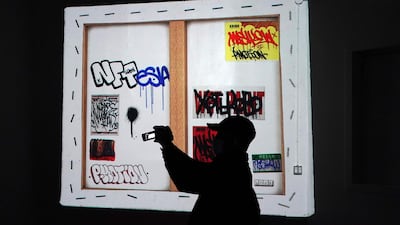While digital art is having a moment after Beeple’s shocking $69 million sale of an NFT-backed piece last month, copycats hoping to cash in might want to focus on the tokens themselves instead of the collectibles.
Since Everydays: the First 5,000 Days set its sales record, the prices of dozens of non-fungible tokens that track ownership and sales prices of digital art have surged – boosting the market almost 10-fold to $20 billion, according to crypto data tracker CoinMarketCap.com. That dwarfs even Bitcoin's meteoric rise in the past few months.
The surge is happening even as observers question whether NFTs, which are also used to control the number of copies in existence through unique identifiers, is the inevitable evolution of the collectibles market or the latest leg in a growing speculative bubble. Several apps and websites are now even offering NFT-backed loans.
“NFTs are a useful idea that will survive, but the current trading mania and extensions like lending will likely fade soon,” Aaron Brown, a crypto investor, said.
That’s not a scenario that coin investors are betting on. Theta Token, used to validate transactions on the namesake corresponding network, has quadrupled this year to reach a market value of $10bn.
The project, focused on peer-to-peer video streaming, plans to let entertainment companies issue NFTs, such as “a piece of all-time classic characters or moments from their favourite shows and movies or a part of an upcoming blockbuster”.
Chiliz, a token to buy fan tokens that can be used for voting in polls of sports clubs such as FC Barcelona, has seen its value rise 23-fold year-to-date to $3bn. It recently announced plans to launch NFTs with professional sports teams, so users can buy these items with Chiliz coins.
Then there are tokens that offer a path to owning of NFTs: Whale, which is backed by a wallet containing thousands of NFTs, lets users “rent” NFTs from the collection, and to purchase exclusive digital swag or even NFTs from the pool.
That coin has doubled since mid-February, a boon for its creator and biggest holder, who goes by WhaleShark.
“People are looking for exposure to NFTs and investing in platform, specific-use NFT tokens as well as asset-based tokens is a way to get into the space without having to hold specific NFTs,” WhaleShark said.
The problem is, coins like Whale are highly illiquid. Its 24-hour-trading volume is about $1m, despite a $214m market value.
Lenders are also beginning to issue NFT-backed loans, which essentially let owners use their NFTs as collateral.
Stani Kulechov, chief executive of liquidity software provider Aave, expects that market will reach $50bn by year-end.
Project NFTfi, around since last summer, has shepherded around $1.8m in loans, with collateral such as virtual cats from CryptoKitties and parcels of land in the virtual world of Decentraland.
“NFT collateralised loans bring additional liquidity to the notoriously illiquid NFT markets,” Stephen Young, chief executive of NFTfi, said. “Our users have done everything from covering margin calls to paying the rent, while going through some tough financial times.”
Still, he noted, default rates range from 10 per cent to 30 per cent – but then, lenders aren’t complaining with demand surging.
Bloomberg

